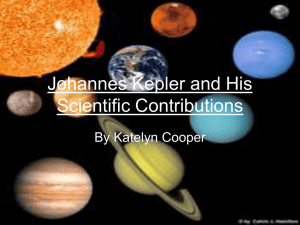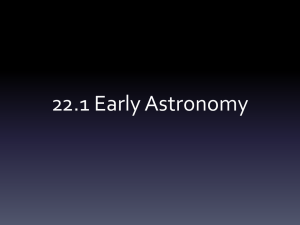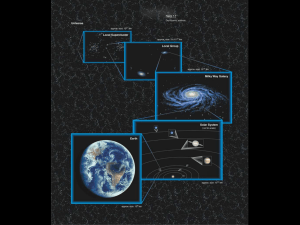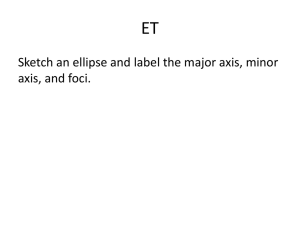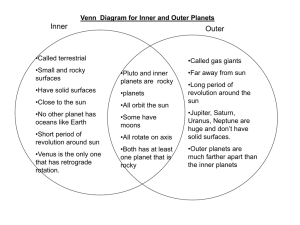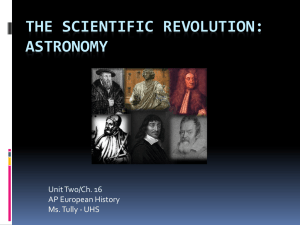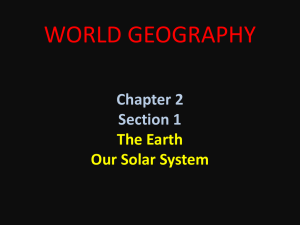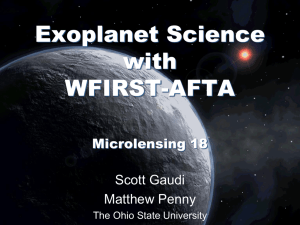Exoplanet Discovery
advertisement
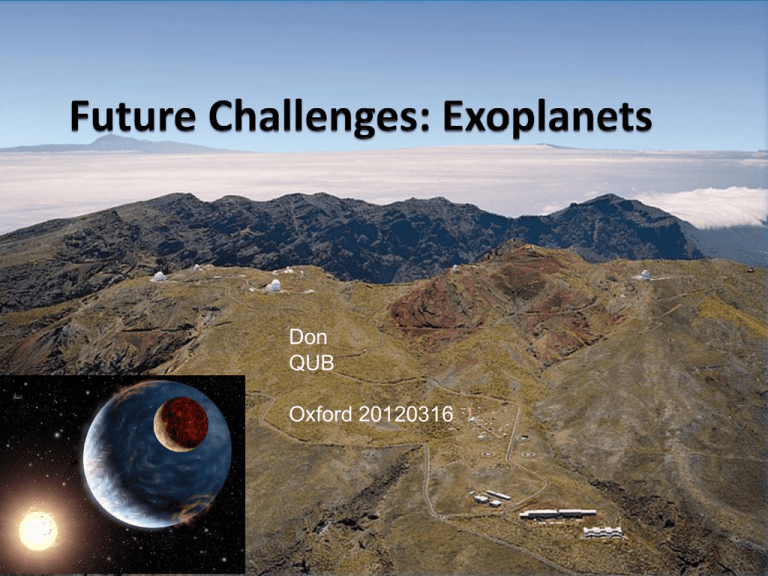
Don QUB Oxford 20120316 Suzanne: purpose of this talk is “refutable comments” In actual fact I think only a crazy person would attempt to predict the ESP future… What is the aim of exoplanet research? Our aims may be quite different from that of our funding bodies. Do we see the “big picture”? While doing the STFC roadmap I originally thought about aims that were, I though, important and in my career horizon eg terrestrial planets and their atmospheres. This was loosely rewritten above me to something like the “Star Trek Boldly go” phase “Seek out new life and civilizations…” So is the life question what its all about? Maybe its not so far away from where we are moving towards – habitability and HZ planets Reflection Before you move forward its time to reflect – that way you can take stock of where you actually are Landmark events 1992 – the pulsar planets (Wolszczan & Frail0) 1995 – first hot jupiter, 51 Peg (Mayor & Queloz) start of RV surveys (continuing) 1999 – first transit detection (Charbonneau et al, Tony et al) start of transit surveys (continuing) (worth pointing out that at this time there was barely a UK ESP community) 2001 – Na in HD209458b (Charbonneau et al, Brown et al) 2005 – first detection of thermal emission with spitzer (Charbonneau et al, Deeming et al) 2007 – (water vapour in ESP atmospheres, Tinneti et al) 2008 – first unambiguous direct images (Kalas et al, Marois et al) (probably other object a few years earlier) 2009 – launch of Kepler, 2 big esp results: size distribution multiple planet systems (>50 HZ planets) (but Kepler is transformational for stellar science) 2010 – first direct spectrum (Janson et al) 2011 – K22b? Kepler Kepler is addressing important question – its prime science driver is hÅ h But Kepler has raised many questions for example: 1) Are planets with R~2RE terrestrial or ice/gas composition 2) Multiple planets eg Why are these systems so flat? 3) Small planets Å Kepler has given an opportunity to look at architectures in a new way - a field day for evolution and dynamics New thinking/themes… Comparative planetology – tentative steps but probably not for a few years for a more thorough investigation. Diversity amongst small planets – Corot7b/K10 (Mercury like) and quite different to many of the K11 components and GJ1214b Planet-star interactions and tidal interactions – the Kepler data has made this a viable subject Planetary atmospheres – Kepler doesn’t help much, but in the future we can imagine looking at ages of planets (astroseismology) and atmospheric composition – what will we find? Planets in different environments especially binary systems and evolved stars sampling long period (relatively high mass) planets Conclusions Exoplanet science is young – still in a discovery/characterisation phase. Fundamental discoveries are still being made – knowledge of ESP atmospheres is at best rudimentary. Theorists need more constraints. Exoplanet science, perhaps not unsurprisingly, driven by technology developments (be it hardware or sometime software (data analysis techniques)). But also creative thinking (which can happen at any time) An Easy Way out – EPRAT 2010 2011-17 2015-22 Post 2020 Ambitious plans don’t last their first clash with reality… Big questions over this timescale What is the diversity and architecture of exoplanetary systems as a function of stellar parameters and birth environment? What is the diversity of the internal structure of exoplanets? What is the diversity of exoplanetary atmospheres? What is the origin of the diversity and how do planets form? What are the conditions for planet habitability, how common is exo-life and can we detect the biosignatures? Missing science Activity – we need to be much smarter in the way we deal with this – it is vital to getting the most out of our esp observations. This has implications – we have little information about planets and early type stars, some sketchy info on evolved stars. We need as many “clocks” as we can get hold of. Formation – still missing an understanding of conglomerates – maybe ALMA? Looking forward Discovery/Characterisation potential technology driven 2012-16 Kepler extended mission? Kepler – looking forward Devils advocate: What more is Kepler going to deliver? We already know ~ the frequency of terrestrial HZ planets (or rather that’s hidden in the data), so why bother? Is it really all about ? hÅ h Å No matter what you think of the ESP future the stellar astrophysics results will be transformational…. (no one has mentioned the heatbeat binaries – its so cool!) Looking forward Discovery/Characterisation potential technology driven 2012-16 Kepler extended mission? 2012-13 The start of “routine” direct imaging Direct Imaging Planets are visible due to scattered starlight or because they are self luminous. The planetary cross-section is small so that scattered starlight is faint compared to host star (table in delta mags): 0.1AU 1AU 5.2AU Earth 20.4 25.4 29.0 Jupiter 15.5 20.6 24.1 Ratio more favourable at IR wavelengths where planets can be self-luminous (depending on temperature). Need to block light from host star (coronagraph). • Resolution: as viewed from 10pc the Earth would be 0.1 arcsec and Jupiter 0.5 arcsec from the Sun. At 100 pc the separations are 10 and 50 milli-arcsec respectively. Telescope resolution (in milli-arcsec) dependant on aperture and wavelength: 500nm 2.2μ 10μ 10m Keck 12.2 54 400 42m ELT 2.9 12.8 58 Optical – resolution ok, contrast bad, IR – resolution worse, contrast better Direct Ground based imaging GPI Coronagraphic devices Large, young, planets at 5AU SPHERE Drivers: high contrast 14-16 mags, high angular resolution 0.1-3 arcsec, sensitivity down to V=10, companions to H~24, spectral resolution R~30 Looking forward Discovery/Characterisation potential technology driven 2012-16 Kepler extended mission? 2012-13 The start of “routine” direct imaging 2013-18 Astrometry begins Astrometric detection Astrometric techniques aim to measure the transverse component of the photocentric displacement. ‘Astrometric Signature’ given by: M PL a PL a= M* d a PL Semi-major axis (AU), d distance (pc) Note – signature scales linearly with semi-major axis (ie better for long period objects), compliments RV technique/transits which have bigger signals at short periods. Astrometric limit given by the non-uniformity of illumination over the stellar disk eg in the case of the sun - a spot covering 1% of disk would cause the apparent centre of the sun to shift by up to 0.005RSun (the wobble induced in the sun by the Earth is has a maximum amplitude ~0.0003RSun). Astrometric First Detections VB10 (Pravdo & Shaklin 2009). Host star is an extremely cool M dwarf 10yr of ground based measurements => 6 MJ companion in 0.74yr orbit Not confirmed by recent results Upcoming experiments PRIMA/VLT (soon), ~30as GAIA (launch 2012/3), ~10as Maybe Sim(-lite) (2020? but not yet funded), 4as Astrometric signal + RV => orbital plane etc 10as would enable the detection of Jupiter’s to 240pc, Uranus’s to 44pc, Earth’s to 1.5pc Looking forward Discovery/Characterisation potential technology driven 2012-16 Kepler extended mission? 2012-13 The start of “routine” direct imaging 2013-18 Astrometry begins 2019 or 2024 EUCLID/WFIRST micrlensing Microlensing First thing – I don’t believe EUCLID or WFIRST will have a microlens programme. Its already not in the EUCLID baseline, and I doubt WFIRST will even be build. But there is good reason for a microlens survey: it’s the easiest way to measure the frequency of terrestrial sized bodies at large orbital periods. There are many problems but this fact stands – there is a case for a mission – we cannot sample this parameter space by any other means Looking forward Discovery/Characterisation potential technology driven 2012-16 Kepler extended mission? 2012-13 The start of “routine” direct imaging 2013-18 Astrometry begins 2019 or 2024 EUCLID/WFIRST micrlensing 2019 JWST JWST Will be transformational in many areas in particular planet formation and atmospheres Spectroscopy, coronagraphic imaging etc Longer term Space Missions: These are actively being studied and in competitions TESS 2017 Explorer class. Bright star transit survey (but the devil or rather the correlated noise is in the detail…) FINESSE 2017 Explorer class. Hot-jupiter spectra PLATO 2024? ESA M3? Bright star transit survey ECHO 2024 ESA M3. Hot-jupiter, ice-giant, and maybe a HZ planet spectra. Whats happened to all the other concepts? Darwin - interferometer Sim(lite) – astrometry TPF-C - coronagraph TPF-I - interferometer SEE-COAST – coronagraph etc There are loads more – too many to list. Why have they fallen away? Answ: mixture of immature technology and community infighting… <this is our biggest danger and stems from our diversity. Is there one mission/concept addressing top level science that the ESP community can gather behind? Lets not forget ground based work RV surveys – ESPRESSO will be built and available from 2015, HARPS-N in the next few weeks (primarily Kepler followup) NGTS (I could ignore it) E-ELT? CODEX/AO Imaging Lessons for young astronomers You need an angle – get attached to a project that will produce. Work on a significant problem. Look forward – try and gauge where the fun will be – right now all the Kepler small planets are in Harvard… The next few years look to be difficult for PDRA positions – go where the job is (WASP/UK students and PDRA’s are involved in Kepler and other projects). Conclusions This is a fast moving, dynamic subject! Stand backWe live at an extremely privileged time where the dreams/thoughts from our ancestors are, for the first time in reach.
